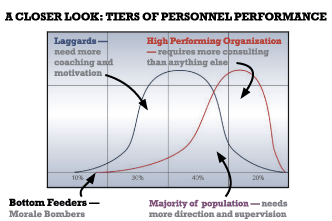Personnel Management: Focus on High-Performing Workers
Managers do not have to babysit these underperforming individuals. Too many managers spend their time doing so. As a result, they do not spend enough time on the ones who really need the coaching, mentoring, and direction. Managers must shift at least some of their focus away from underperformers and pay more attention to technicians whose performance can truly benefit the organization.
I can break every organization's workforce into four categories:
Superstars. These workers make up the top performing 20 percent of any department. They require little motivation or supervision. They do their jobs well. What they require from their supervisor is support. They need someone they can ask suggestions of but who does not micromanage them.
Dependables. These workers represent about 40 percent of the workforce. They need more supervision and direction than superstars. The individuals come to work every day and do their jobs well. But dependables are equally focused on their lives outside of the workplace. A supervisor should spend time with this group by helping direct their activities.
Laggards. Workers in this group account for about 30 percent of the workforce, and supervisors and managers need to spend the most time with them. Laggards are not self-motivated and show little initiative. Their typical response is to wait and see the way things turn out. Managers must identify these individuals and spend time coaching, motivating, and mentoring them to elevate their performance. The goal is to turn laggards into dependables.
Morale bombers. The fourth and final group of workers account for the bottom 10 percent. These individuals bring the whole staff down. Managers often feel there is very little they can do to change the behaviors of these people. These workers have the largest impact on department morale and consume most of a manager's time. Managers should encourage morale bombers to get on board through coaching and motivation. If this approach does not work, managers should try to minimize their impact on group morale.
Shifting Toward Results
The chart below illustrates this point. The blue line represents a typical manager's personnel focus, given the ratio of the four categories, with greater emphasis on laggards and morale bombers. The red line represents my recommended shift in the focus, with more attention on superstars and dependables.
This shift is a fundamental change for managers. Those who succeed will have invested their efforts and resources in developing groups of workers with higher productivity and performance potential.
In addition to the productivity benefits, this shift also means managers will have more time to supervise, coach, motivate, direct, and manage the business — their real responsibilities. Imagine how many more activities you could confidently delegate, or how much better department morale would be.
By moving the bell curve to the right, you will develop high-performing technicians. Managers must stop being the vice president of child-care services and focus on the responsibilities that go with their real job titles.
Agree? Disagree? Have something to say?
We want to hear from you. Visit myfacilitiesnet.com/members/Andrew-Gager/default.aspx, and "Start a Conversation."
Andrew Gager, CMRP, CPIM, is director of consulting services with Marshall Institute, an asset management consulting and training company that helps companies improve the maintenance contribution to organizational performance. Gager has more than 25 years of experience, ranging from warehousing operations to plant manager.

Related Topics:













